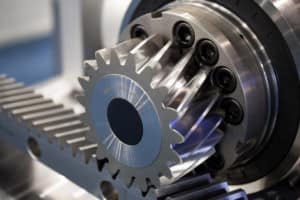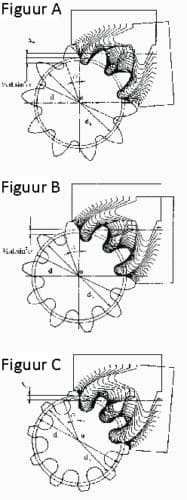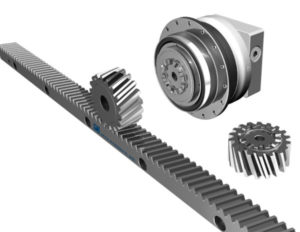Why does the ideal pinion have 20 teeth?
 Why does Apex Dynamics advise about 20 teeth for the pinion, why not more or less? Why doesn’t the values of the feed force simply increase with a larger number of teeth? We discuss the advantages and disadvantages of pinions with both more and fewer teeth and how this is determined to a significant extent by the application. We also share the various solutions, interfaces and quality levels in a handy overview. After reading this article you know exactly which pinion you need!
Why does Apex Dynamics advise about 20 teeth for the pinion, why not more or less? Why doesn’t the values of the feed force simply increase with a larger number of teeth? We discuss the advantages and disadvantages of pinions with both more and fewer teeth and how this is determined to a significant extent by the application. We also share the various solutions, interfaces and quality levels in a handy overview. After reading this article you know exactly which pinion you need!
Pinion with less than 20 teeth
Due to the design of the pinion with fewer than 20 teeth, a profile change factor often has to be used, whereby the working diameter is corrected: this becomes the “dw”. Unfortunately, this also leads to a tooth profile change, which is caused by undercutting :
 The undercutting is a nasty side effect in the production of gears. When the tooth number of a milled gear )according to the unwinding system) is below the limit number of 17 (at a pressure angle of 20°), the tooth base shows a hollow; the smaller the tooth number, the greater the cavity.
The undercutting is a nasty side effect in the production of gears. When the tooth number of a milled gear )according to the unwinding system) is below the limit number of 17 (at a pressure angle of 20°), the tooth base shows a hollow; the smaller the tooth number, the greater the cavity.
This hollowing weakeness the tooth base, so that the fracture sensitivity increases. This also removes an important part of the evolving flank below the pitch circle, so that this part of the flank no longer has any contact during engagement.
To clarify this, look at the drawing of a 10-tooth gear with a pressure angle of a = 20° in three different versions.
- Figure A was adjusted by applying a correction x = + 0.5. This tooth has a wide tooth base.
- Figure B, no correction was applied, but a slight undercutting can be observed, given the small number of teeth. The teeth have a slightly weakened tooth base
- Figure C emphasized the undercut by applying a negative correction of x = – 0.5. The tooth foot is greatly weakened here and the undercutting is clear.
Pinions with fewer than 20 teeth have a poorer functioning of the gear pair, characterized by more noise, vibrations, faster wear and, more importantly, less resistance to breakage. This problem can be solved by increasing the pressure angle; reducing the tooth height; shifting the unwinding zone during milling; or through a combination of these different options. However: pinions and racks must be interchangeable between the different providers, so an adjustment is not desirable.
Pros and cons pinion with less than 20 teeth
- Disadvantages:
- Lower torque due to the adjusted involute at the tooth base.
- Faster wear due to the higher pinion speeds.
- Less resistance to breakage due to the narrower tooth base.
- Advantage:
- More precise due to the small diameter.
Pinion with more than 20 teeth
In many ways to build a pinion on the gearbox, it is easy to use (many) more than 20 teeth. There is no risk of undercutting, so there is no question of a profile shift factor and the tooth base remains nice and wide. You would say ideal, but there are still reservations. Bigger is not always better (space consumption in the machine) and to keep the speed of the drive lower, you need more reduction, which often leads to a multi-stage gearbox. For direct drives, the encoder must have a higher resolution.
Pros and cons pinion with more than 20 teeth
- Disadvantages:
- Inaccurate. If there is a small play in the drive, this will be magnified due to the larger diameter of the pinion.
- Lower feeding power. The torque to be transmitted increases slightly, but the feeding power decreases. (T = F * a)
- Higher reduction: For the pinion with 30 ~ 40 teeth, a gearbox with a high ratio must be aplied. A gearbox with a higher ratio is often more expensive and often has a more backlash.
- Advantage:
- Easy assembly and relatively inexpensive.
 Summary
Summary
Empirically, a pinion with approximately 20 teeth is optimal. That is why Apex Dynamics has invented the “Curvic Plate” pinion, in which the torque, backlash, wear and service possibilities are optimal. With service possibilities is meant that the pinion is easy to exchange. Suppose you have a complete drive of motor, gearbox and rack/pinion, then the pinion will often be the most sensitive to wear (at least with hardened and ground racks.) The reason for this is the mechanical contact with the rack and the open system.
This pinion can easily be changed by loosening the central bolt, after which the pinion can be removed from the curvic-plate flange. The Curvic-plate pinions are stock items at Apex Dynamics and can therefore be delivered fast.
Overview pinions
An overview of the possible pinions:
| Code | A | B | C | D | E | F | G | H |
| Description | Curvic plate | Laser welded | Bolted on flange | Spline | Key way | Key way with or without shrinkdisc | Shaft with keyway | Shaft without keyway |
| Interface | DIN9409 | DIN9409 | DIN9409 | DIN5480 | For AE/AF/PII | Shaft with key way | Hollow shaft with key way | Hollow shaft with shrinkdisc |
| Quality pinion | 4 | 4 | 4 | 5 | 5 | 5 | 5 | 5 |
| Spur/Helical gear | Spur and Helical | Spur and Helical | Helical | Helical | Helical | Spur and Helical | Spur and Helical | Spur and Helical |
| Number of teeth | Ca. 20 | <20 >20 | >20 | Ca. 20 | <20 >20 | Ca. 20 | <20 | <20 |
| Accuracy | +++ | +++ | ++ | ++ | ++ | + | + | ++ |
| Service possibility | +++ | ++ | ++ | ++ | ++ | +++ | ++ | ++ |
| Assembled delivery | Yes | Yes | Yes | Yes | Yes | No | No | No |
 Summary
Summary



